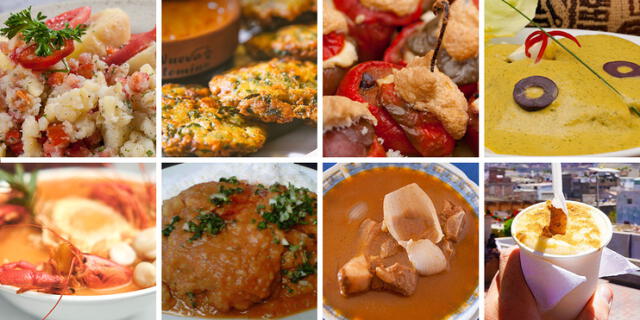Hello bloggers! Today we are going to talk, write about the 5 typical dishes of Arequipa. Learn more by reading our blog below.
It is a cuisine that combines flavor and art; it seeks harmony between taste, color, and shape. Its goal is to stimulate the senses of the diner, as well as activate the functioning of the body’s organs. Thus, flavors, aromas, textures, shapes, and colors blend in delicate clay pots and wood-fired stoves, creating delicious dishes.

The gastronomy of Arequipa in Peru is a spectacle of flavors, colors, and textures. Here are some of the most iconic dishes:
About Arequipa’s Gastronomy:
It is a mestizo cuisine; a fusion of ancient Aymara, Puquina, and Quechua culinary traditions with Spanish-Moorish influences. This culinary symbiosis gave rise to refined and highly valued dishes that have transcended both national and international levels, such as stuffed rocoto peppers, shrimp soup, fried guinea pig, spiced dishes, and a wide variety of light and dark broths.
1 – Rocoto Relleno (Stuffed Spicy Pepper):
The most famous dish from Arequipa. It consists of a rocoto pepper (a spicy chili) filled with ground beef, peanuts, cheese, and spices, baked with melted cheese on top. Its combination of spiciness and creaminess makes it unmatched.
This mixed-dish combines native Andean ingredients with others that arrived with the Spanish in the 16th century.
Its origin remains a mystery and has even been the subject of a fictional story, which in itself is a delight: “The Story of Manuel Masías, the Man Who Created the Stuffed Rocoto and Cooked for the Devil” by Carlos Herrera. In picanterías (traditional restaurants), it is often prepared together with potato pancakes cooked in shell-like clay molds, used like ovens in traditional kitchens.
2 – Dessert – Queso Helado (Ice Cream Cheese):
There is no definitive history behind queso helado. We know that during the colonial period in the 16th century, milk, spices, and European cooking techniques arrived in the country. It is said to have been created inside the Santa Catalina convent by its nuns, like many other desserts and traditional dishes of Arequipa’s cuisine. However, its peak came in the 18th century, when other ice creams also began appearing in major Peruvian cities.
This is the traditional dessert of Arequipa — an ice cream made with fresh milk, coconut, sugar, and cinnamon. In the city of Arequipa, it was originally made at the San Camilo market using steel churns manually rotated over layers of ice. But today, you can easily find it anywhere in the city.
3 – Chupe de Camarones (Shrimp Chowder):
Arequipa-style shrimp soup has its roots in pre-Columbian times, with origins tracing back to pre-Hispanic soups based on local ingredients like shrimp, fish, cassava, and corn.
With the arrival of the Spanish and the subsequent cultural fusion, the recipe evolved by incorporating European ingredients such as milk and cheese, along with yellow chili, which gives it its characteristic flavor and color. The dish became a symbol of Arequipeña gastronomy and is widely consumed in the region’s picanterías.
4 – Ocopa Arequipeña:
Ocopa is one of the most representative dishes of Arequipa’s cuisine. Its origins date back to the time of the Inca Empire, when chasquis (Incan messengers) carried in their travels a bag called “ocopa” containing chili peppers, ground peanuts, and herbs. By the late 19th century, ocopa was considered a spicy dish in itself and was popular during holidays.
It is a thick and aromatic sauce made with mirasol chili, huacatay (an Andean herb), peanuts, and fresh cheese, traditionally served with boiled potatoes. This dish perfectly blends pre-Columbian culinary traditions with Spanish influences, resulting in a cold dish ideal as an appetizer or side.
5 – Cuy Chactado (Fried Guinea Pig):
It is a typical dish from Arequipa, Peru. It consists of guinea pig fried in plenty of oil until crispy, usually served with potatoes, corn, and spicy sauces. It is typically served whole, with golden, crunchy skin.
History:
Ancestral Origins:
Guinea pig consumption dates back to pre-Inca times, when it was a staple food with cultural and ritual significance.
Inca Period:
During the Inca Empire, guinea pig was valued not only for its meat but also for its use in religious ceremonies and healing rituals.
Traditional Dish:
Over time, cuy chactado (fried guinea pig) became a traditional dish in various Andean regions, especially in areas such as Arequipa and Cusco. Guinea pig remains a popular dish in Peru, with National Guinea Pig Day celebrated every Friday of the second week in October to promote its consumption.
Contact Us:
For more information, please contact us DREAMY TOURS, we will be happy to answer all your questions about Peru, Bolivia and Chile.
We specialize in tours and travel packages as a Travel Agency. If you need information, please contact us.
We offer tours, excursions – Peru – Bolivia – Chile:










